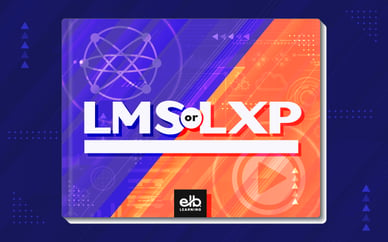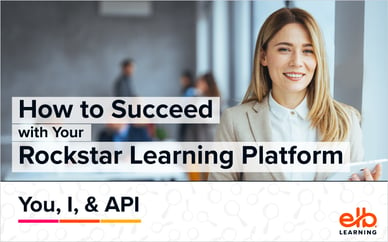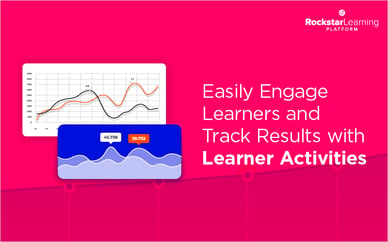|
For: Chief Learning Officers, Learning and Development Managers, Learning Strategy Engineers, Training Program Managers, and Instructional Designers Downloads: Click here to download the eBook and printable worksheets |
A proactive approach to collaborative, cross-organizational learning strategy initiatives enables learning and development teams, talent development teams, training teams, and instructional design teams to reposition as impact makers, rather than order takers, within their organization.
It's not easy for L&D leaders to bring together a cross-functional team of stakeholders from different business units, departments, or groups within their organization to step away from day-to-day demands and come together for focused, uninterrupted, brainstorming and collaboration to plan a major initiative. Yet, creating a cohesive vision to get the initial momentum your team needs to really move the needle in your organization requires exactly that. And, even with the best laid plans, how do you know that what you’re planning to do will work? How do you know it will be valuable, usable, and feasible?
Working through the process of planning and executing a proof-of-concept, together with your team, will enable you to demonstrate your expected return on investment (ROI)—not just hypothetically, but with actual results.
Additionally, a proactive approach to collaborative, cross-organizational learning strategy initiatives enables learning and development teams, talent development teams, training teams, and instructional design teams to reposition as impact makers, rather than order takers, within their organization.
This article provides an overview of how to conduct a learning strategy initiative proof-of-concept exercise with your team using the Rockstar Learning Proof-of-Concept ModelTM.
For additional guidance, download the eBook and printable worksheets.
Get on the list for our next Rockstar Learning Proof-of-Concept Model Workshop to try out the POC planning process with guidance.
This model can be used for all kinds of learning strategy initiatives, including, but not limited to:
- Planning for and buying an LMS, LXP, or digital learning platform
- Consolidating or diversifying your organization’s learning technology strategy
- Addressing digital and online learning needs that have shifted or expanded
- Finding ways to better leverage value of an existing system
- Changing your learning paradigm
- Innovating beyond existing models and practice
For the purpose of this article, we’ll look at applying the Rockstar Learning Proof-of-Concept ModelTM to planning for and buying an LMS, LXP, or digital learning platform as our example.
Readiness Checklist
Before you’re ready to start your proof-of-concept planning and execution, you need to complete the following steps:
- Assemble Your Team
- Decide What Matters
- Find Your Solution
Assemble your team.
When you’re going into the process of finding and purchasing an LMS or LXP, it’s really easy to get stuck in a couple of traps. Here are two things you DON’T want to do.
First, don’t get stuck in the trap of focusing only on your own use cases. You need to look beyond your team, group, or business unit to see who else in your organization might benefit from a digital learning platform and find out what use cases are important to them.
You might be looking for a solution to deliver new hire, safety, compliance, and regulatory training, but don’t stop there. How about professional certification, micro credentialing, and badges?
Don’t stop with, “I need an LMS to deliver HR compliance and skills training,” or even with, “…to provide certification for employees,” but also think about how you can empower your workforce with opportunities for professional development and individual growth.
Don’t just satisfy the need for compliance and skills training but fuel the passion of interest so you can engage your employees and attract and retain top talent.
Second, don’t get stuck in the trap of only focusing on your immediate needs. Create a vision of what digital learning looks like in your organization 5-10 years from now, and make sure you're thinking about how the investment you make today can grow with you over time.
The best way to accomplish these goals, and avoid these two traps, is to assemble a cross-functional team that can bring a variety of use cases, problems, and opportunities to the table and work with you to create a vision that’s bigger and better than what you might come up with on your own.
|
How many stakeholders should be involved? When it comes to assembling your team, the answer to this is, “It depends,” but here are a few guidelines.
Although this might start out for you as an HR or L&D initiative, by ensuring good representation from across the organization, you’re going to end up making better decisions and a better investment that will yield significant dividends |
Decide what matters.
More isn’t always better. A few years ago when I was shopping for a new LMS, I determined that there were really only five things that mattered most for my organization: the ability to upload video as our primary form of learning content; add simple knowledge checks and activities for learner engagement; provide certification; report on content views, progress, and completion; and integrate with our identify provider so that end users wouldn’t have to remember yet one more username and password or log in twice. That was it.
Now, yes, we had lots and lots of SCORM content and courses that had been produced by our team of instructional designers—several years’ worth actually—but we were a product company and the products were always evolving and changing. A large portion of our existing training content had become outdated, was in need of being updated, or would soon become irrelevant.
It was also the case that new product features were being created so quickly that our team of now only one senior instructional designer couldn’t keep up. And, in reality, all of the raw material for new content was coming from recorded live events, webinars, and Zoom meetings.
Fortunately, we now live in a world where there is a much lower bar for content quality than there has been in the past—that is, knowledge consumers prefer content with an acceptable level of quality now over content with a higher level of quality later. Because of this, we decided (and this is important) in concert and consultation with our stakeholders that importing older content or the ability to create other types of interactive content really wasn’t a deal breaker for us. Importing the older content wasn’t going to move the needle, at least not in the short term, and as long as we could find a platform to meet our 5 key needs—for video, learner engagement, certification, reporting, and single sign on—we would both meet our immediate goals and be well positioned for the future.
|
Instead of long feature lists to compare vendors, identify key workflows or functionality that matter most to your learning strategy initiative. |
Find your solution.
Once you’ve decided what matters most to you, and have identified key use cases and functionality, it’s time for you to find your solution (i.e., your vendor or product).
One of the more typical approaches people take on this, traditionally, is to issue an RFP (a Request for Proposals). While that approach has its merits it’s kind of like meeting someone for the first time and saying, “Will you please answer the following 400 questions spread across 8 Excel worksheets, supplemented with 5 lengthy Word documents, plus 10 other documents I’d like you to provide, just so I can get to know you and decide whether or not we’re compatible?”
In terms of relationships, that’s probably not the best way to get started and it’s a lot of work for you and your team and for the vendors. Ironically, in my experience as both a buyer and vendor, the value of the information you get is pretty marginal. In fact, it’s not uncommon for you to have to go back to vendors and say, can you provide additional explanation for your responses to the following 80 questions. You end up going back and forth, multiple times, with this process and it takes a huge investment on both sides.
It’s a little bit like bringing a candidate in for a full circuit of interviews with the team without first conducting a screening interview. Who would do that?
So, while the RFP process has its merits and is certainly appropriate in some cases, it’s expensive and may not be worth the investment for you.
What I recommend, instead, is sending out a questionnaire. One way I’ve seen this done effectively is with Google Forms, where the number of questions is limited to maybe 20 or 30—all short answer or multiple choice. Rather than focusing on a comprehensive profiling of vendors and their learning platform technology, questionnaires can help you quickly identify possible solutions that provide key functionality you and your team have determined matters most for your organization.
After reviewing responses to your questionnaire from multiple vendors, you can select a few likely matches to provide demos of their products with time for Q&A, request access to sandbox environments, and then pick a vendor to work with on your proof-of-concept.
|
Rather than issuing a lengthy RFP, use a short screening questionnaire to find suitable products and vendors. This can be done effectively with tools like Google Forms or Survey Monkey. Keep it simple and easy, no more than 30 questions, all short answer or multiple choice. This will enable you to quickly identify possible solutions that offer key functionality you and your team have determined matter most and avoid wasting time on a comprehensive profiling and comparison of competing vendors and technologies. Be sure to ask whether or not the vendor is willing to conduct a proof-of-concept with you—not just provide access to a free trial or evaluation sandbox, but to engage in a 2-4 week process where you and the vendor work together to build out specific use cases in the product, put them in front of real learners, facilitators, and administrators, and demonstrate success! |
Get on the list for our next Rockstar Learning Proof-of-Concept Model Workshop to try out the POC planning process with guidance.
Three General Goals of the POC
As you’re getting started with planning your POC, keep in mind that you have three general goals
- Demonstrate expected value
- Mitigate risks
- Represent all of your stakeholders
In the context of an LMS proof-of-concept, demonstrating expected value means, literally, that. It means showing your team a working example, in the LMS, of each of your targeted use cases---and even letting them experience first hand.
Mitigating risk means you’ve dug far enough in, on features and functionality that are critical to your success, to know what is and isn’t possible—this usually applies, in particular, to technical capabilities like importing files, exporting data, or integrating with other systems; importing or creating content; capturing evidence of learner understanding, engagement, competence, or completion; and generating reports. If, in the process, you discover that some critical function or capability you were hoping for isn’t available, you need to determine if there is a suitable and viable workaround.
The best way to accomplish the third general goal, representing your stakeholders, is to include them in the process. Give them a chance to experience the type of interaction they’ll have with the learning platform when it is fully implemented, and include them in your POC team demos and reviews. We’ll talk about this more when we get to Executing Your POC.
Planning Your POC
Now let’s talk about planning your POC. There are four steps:
- Choose your focus (i.e., identify specific target use cases)
- Identify specific objectives
- Define success criteria for each objective
- Lay out a timeline with weekly milestones
You can’t do everything. Remember, a proof of concept is a targeted implementation during which product functionality is evaluated against specific use cases—these are the use cases that are important to you and your stakeholders. In planning your POC you’ll need to choose your focus--that means pick one, two, maybe three, target use cases and accompanying, specific, objectives for each use case. Not a whole list of use cases. Not a handful. Not even a short list. Just one, two.... maybe three.... maximum.
One of the biggest problems organizations and teams have is focusing. So, be aware of that, and take my advice that you’ll do much better to focus your POC on just one or two really critical target uses that are going to move the needle in your organization.
You’ll also need to clearly define what success means for those objectives, and lay out an overall timeline with defined milestones.
Choose your focus.
This, honestly, will probably be the most challenging step for you and your team, but getting it right, will pay dividends.
As you’re Choosing Your Focus, let those three goals of the POC that we just talked about (demonstrating expected values, mitigating risk, and representing all of your stakeholders) steer you to the right set of use cases for your POC.
Choosing your focus goes back, primarily, to the question of, “What problem are you trying to solve?”, or “What opportunity would you like to take advantage of?” This is your justification for setting out to buy an LMS, LXP, or digital learning platform in the first place. Here are a few possible examples:
- Virtual Onboarding and New Employee Skills Training
- Classroom to Virtual: Converting ILT to vILT
- Retaining Top Talent: Upskilling and Reskilling
- New Learning Paradigm: Manuals to Mobile Video
One of the more common cases we’re seeing this year is a need to implement some type of virtual onboarding program. Hiring new employees in our mostly WFH environment presents unique challenges for the onboarding process, which may include: pre-hire skills assessment, certification, or licensing; new hire orientation of polices, process, and culture; and initial and ongoing compliance and regulatory training, sexual harassment and diversity training, safety training, continue education credit, re-certification, and skills training. If this is your focus—virtual onboarding—you might be interested in learning platforms that provide some type of immersive content like a virtual office tour, as well as the ability to deliver and track completion of required training modules.
Another very common example we’re seeing in the industry is a forced transition from classroom-based training to virtual face-to-face or online digital learning. In cases like these classroom trainers are now becoming online learning facilitators and are going through the process of converting classroom learning materials to online materials and figuring out new ways to engage learners and assess competency. One key piece of functionality you might look for in this case is the ability for learners to upload evidence of demonstrated skills.
Another possible example might be implementing a learning platform as part of an initiative to recruit and retain top talent by providing opportunities for professional development and individual growth. You may already have a system to deliver mandatory compliance, regulatory, and safety training, but it may not be possible with that system to include opportunities for self-directed learning in pursuit of individual professional interests. In this case, you might be looking for a learning experience platform that includes an off-the-shelf course library for things like soft skills development, upskilling, reskilling, or cross training.
In our last example, you might be in a position where you need to make a learning paradigm change. Perhaps your focus is on transitioning from instructor-led, binder-based training to video-based mobile learning. If this is what you’re after, you’ll want to validate the process for creating, delivering, and experiencing video-based training in the learning platform you’ve selected.
Identify specific objectives.
The next step in planning your proof-of-concept is to specify objectives for each of your target use cases. As an example, let’s look at possible objectives for each of the four target use case examples described above.
For Virtual Onboarding, specific objectives might include:
- Posting a welcome video into an onboarding learning track facilitated by the learning platform
- Providing a virtual office tour
Alternatively, or maybe in addition to that, you might have a use case for safety training (remember though, you want to focus on one to three use cases, max, per team). The objectives for this use case could include:
- Adding a Fire Safety course to the learning platform
- Enrolling learners in the course
- Having learners take and complete the training
For Classroom to Virtual, specific objectives might include:
- Scheduling a live Zoom event in the learning platform
- Verifying that participants receive an email with an add-to-calendar link so they can add the event to their Outlook or Google calendar
- Having real people in your organization participate in the event
- Having attendees enter a completion code for the event into the learning platform to get credit for attendance
For Retaining Top Talent, specific objectives might include:
- Demonstrating learner ability to browse and search the learning platform’s integrated course library
- Demonstrating learner ability to mark courses as favorites or self-enroll
- Demonstrating automated learner email notifications and reminders
- Tracking and monitoring the topics and skills your employees are most interested in
For New Learning Paradigm, specific objectives might include:
- Upload a 5-minute training video
- Add an interactive viewing guide for the learner to better follow along with and engage with the video
- Demonstrate learner ability to upload a picture or video of their own to demonstrate their ability to complete the skill being taught
- Review, as a facilitator or coach, the learner’s completed viewing guide and submitted evidence
Define success criteria for each objective.
After you’ve chosen your focus by identifying key use cases and objectives, your next step is to define success criteria.
Your definition of success, which is also your exit criteria for those use cases in the POC, might be as simple as, “Successful demonstration in the learning platform of all objectives.”
Other ways to define success might include specific criteria, for example:
- “Employees are able to search for, and enroll, in courses of interest.”
- “Customer Support Representatives are able to provide accurate information regarding the functionality of new feature X.”
- “Sales representatives successfully demonstrate feature X, including 3 key value statements and solicitation of a response from the prospect regarding how they could see themselves using this feature in their organization.”
One of the factors that makes the Rockstar Learning Proof-of-Concept Model™ approach so powerful is that it enables you to demonstrate real value by showing how the digital learning platform solves a fundamental problem for your organization. In the last example above, this value is demonstrated by delivering product training for your sales representatives and using the digital learning platform to facilitate coaching to connect value with real customer needs during product feature demos.
Get on the list for our next Rockstar Learning Proof-of-Concept Model Workshop to try out the POC planning process with guidance.
Lay out a timeline with weekly milestones.
The last step in planning your proof of concept is to define milestones with start dates, end dates, and a schedule of your planned objectives for each milestone.
Each one of the stakeholder groups participating in the POC should have objectives scheduled in each milestone. I recommend that you have no more than 4 milestones and that each milestone be no more than one to two weeks long.
|
At the end of your POC planning you should have a clear idea of what your purpose is for conducting the POC, who your stakeholders are, what their key use cases and objectives are, and a timeline for execution. All of that should be captured on the included POC Planning One Sheet. Click here to download the eBook and printable worksheets. |
Executing Your POC
With your POC Planning One Sheet in place, you’re ready to move forward. The following guidelines will help you effectively execute your proof of concept.
Assign a single owner to drive the process.
As you get started, it’s important that you assign a single owner and driver of the POC process. This can be anyone in the group. Often the team functions better and more openly when the driver of the process is NOT the people manager or business owner for the initiative, but rather a volunteer or nominee from the team who is good at managing processes, tracking details, scheduling meetings, and facilitating group interactions.
Identify roles and responsibilities of team members.
One of the first responsibilities of the POC Process Owner is to capture and record roles and responsibilities for all team members. This statement of roles and responsibilities should clearly state who each stakeholder is representing and what they are responsible to deliver during the POC.
Assign and track tasks.
The second responsibility of the POC Process Owner is to note, track, and facilitate reporting of assignments. These assignments will likely not be all defined and assigned upfront but will be identified and assumed by team members as the POC progresses.
Hold weekly end-of-milestone checkpoints with team demos.
Assignments typically evolve out of the initial kickoff meeting and end-of-milestone checkpoints when the team meets to review status and results. Plan on spending 30-60 minutes for each meeting. The POC Process Owner schedules and facilitates the initial kick-off meeting and the end of milestone checkpoints.
For your proof-of-concept to be effective, the core of your end of milestone checkpoints should be team demos. During the demos, individual members of the team show in the learning platform an example that demonstrates the objective assigned to them, targeted for that week’s milestone. Feedback, notes, and issues should be noted in the POC Tracking Sheet, also included with this eBook.
Track progress visually.
As you progress through your POC, the Process Owner should mark off objectives and success criteria on the POC Planning One Sheet, which becomes your visual tracker, so that the entire team has visibility into progress and results as you visit each objective and complete each milestone.
Conclusion
At the end of your POC, you will have a defined business case argument and results from a targeted implementation of the learning platform during which product functionality was evaluated against specific use cases, critical to your learning program initiatives.
As you wrap up your proof-of-concept exercise, spend enough time discussing the results as a team so that you are unified in your recommendation. Present your findings in the natural flow of the business case argument. Your concluding statement should be something like, “Having successfully met these criteria in our proof-of-concept exercise, we have a high level of confidence that we will be able to produce the results we are looking for, to get the return on investment we expect, and we are all in agreement as a team that we should move forward.”
For more information on how to conduct a learning platform proof-of-concept exercise, download the eBook and printable worksheets.
Get on the list for our next Rockstar Learning Proof-of-Concept Model Workshop to try out the POC planning process with guidance.







